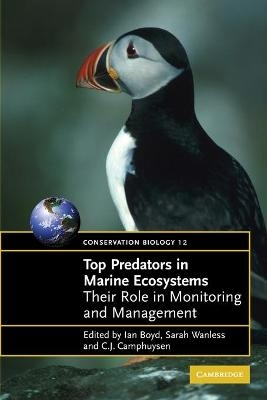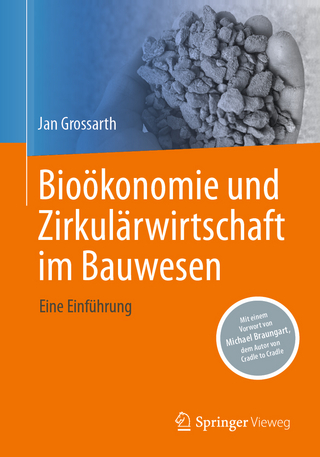
Top Predators in Marine Ecosystems
Cambridge University Press (Verlag)
978-0-521-61256-2 (ISBN)
The sustainable exploitation of the marine environment depends upon our capacity to develop systems of management with predictable outcomes. Unfortunately, marine ecosystems are highly dynamic and this property could conflict with the objective of sustainable exploitation. This book investigates the theory that the population and behavioural dynamics of predators at the upper end of marine food chains can be used to assist with management. Since these species integrate the dynamics of marine ecosystems across a wide range of spatial and temporal scales, they offer new sources of information that can be formally used in setting management objectives. This book examines the current advances in the understanding of the ecology of marine predators and will investigate how information from these species could be used in management.
Ian Boyd is Director of the Sea Mammal Research Unit at the University of St Andrews. He is a Fellow of the Royal Society of Edinburgh and a recipient of the Bruce Medal of the Zoological Society of London for his scientific studies in Antarctica. Sarah Wanless of the NERC Centre for Ecology and Hydrology, works on long term studies of bird populations. C. J. Camphuysen's current research interests include foraging ecology, mortality and distribution patterns of seabirds in the Atlantic Ocean and in the North Sea, the impacts of fishing on marine birds and the spatial distribution and temporal trends in abundance of cetaceans in the North Sea.
Preface; 1. Introduction I. L. Boyd, S. Wanless and C. J. Campheysen; 2. Effects of fisheries on ecosystems: just another top predator? Andrew W. Trites, Villy Christensen and Daniel Pauly; 3. Physical forcing in the southwest Atlantic: ecosystem control P. N. Trathan, E. J. Murphy, J. Forcada, J. P. Croxall, K. Reid and S. E. Thorpe; 4. The use of biologically meaningful oceanographic indices to separate the effects of climate and fisheries on seabird breeding success B. E. Scott, J. Sharples, S. Wanless, O. Ross, M. Frederiksen and F. Daunt; 5. Linking predator foraging behaviour and diet with variability in continental shelf ecosystems: grey seals of eastern Canada W. D. Bowen, C. A. Beck, S. J. Iverson, D. Austin, and J. I. McMillan; 6. Distribution and foraging interactions of seabirds and marine mammals in the North Sea: multi-species foraging assemblages and habitat-specific feeding strategies. C. J. Camphuysen, Beth Scott and Sarah Wanless; 7. Spatial and temporal variation in the diets of polar bears across the Canadian Arctic: indicators of changes in prey populations and environment Sara J. Iverson, Ian Stirling, and Shelley L. C. Lang; 8. Biophysical influences on seabird trophic assessments W. A. Montevecchi, S. Garthe and G. K. Davoren; 9. Consequences of prey distribution for the foraging behaviour of top predators Iain J Staniland, Phil Trathan and Anthony R. Martin; 10. Identifying drivers of change; did fisheries play a role in the spread of North Atlantic fulmars? Paul M. Thompson; 11. Monitoring predator-prey interactions using multiple predator species: the South Georgia experience J. P. Croxall; 12. Impacts of oceanography on the foraging dynamics of seabirds in the North Sea F. Daunt, S. Wanless, G. Peters, S. Benvenuti, J. Sharples, D. Grémillet and B. Scott; 13. Foraging energetics of North Sea birds confronted with fluctuating prey availability M. R. Enstipp, F. Daunt, S. Wanless, E. M. Humphreys, K. C. Hamer, S. Benvenuti and D. Grémillet; 14. How many fish should we leave in the sea for seabirds and marine mammals? Robert W. Furness; 15. Does the prohibition of industrial fishing for sandeels have any impact on local gadoid populations? Simon P. R. Greenstreet; 16. Use of gannets to monitor prey availability in the NE Atlantic Ocean: colony size, diet and foraging behaviour Keith C. Hamer, Sue Lewis, Sarah Wanless, Richard A. Phillips, Tom N. Sherratt, Elizabeth M. Humphreys, Janos Hennicke and Stefan Garthe; 17. Population dynamics of Antarctic krill Euphausia superba at South Georgia - sampling with predators provides new insights K. Reid, E. J. Murphy, J. P. Croxall and P. N. Trathan; 18. The functional response of generalist predators and its implications for the monitoring of marine ecosystems Christian Asseburg, John Harwood, Jason Matthiopoulos and Sophie Smout; 19. The method of multiple hypotheses and the decline of Steller Sea Lions in western Alaska Nicholas Wolf, Jason Melbourne and Marc Mangel; 20. Modelling the behaviour of individuals and groups of animals foraging in heterogeneous environments J. G. Ollason, J. M. Yearsley, K. Liu and N. Ren; 21. The scenario Barents Sea study: a case of minimal realistic modelling to compare management strategies for marine ecosystems Tore Schweder; 22. Setting management goals using information from predators Andrew J. Constable; 23. Marine reserves and higher predators Sascha K. Hooker; 24. Marine management: can objectives be set for marine top predators? Mark L. Tasker.
| Erscheint lt. Verlag | 11.5.2006 |
|---|---|
| Reihe/Serie | Conservation Biology |
| Zusatzinfo | 9 Tables, unspecified; 4 Halftones, unspecified; 81 Line drawings, unspecified |
| Verlagsort | Cambridge |
| Sprache | englisch |
| Maße | 153 x 229 mm |
| Gewicht | 632 g |
| Themenwelt | Naturwissenschaften ► Biologie ► Ökologie / Naturschutz |
| ISBN-10 | 0-521-61256-X / 052161256X |
| ISBN-13 | 978-0-521-61256-2 / 9780521612562 |
| Zustand | Neuware |
| Haben Sie eine Frage zum Produkt? |
aus dem Bereich


